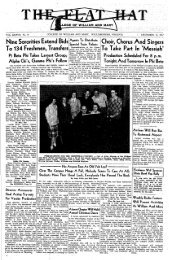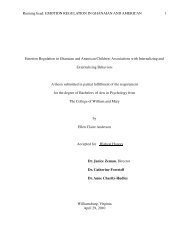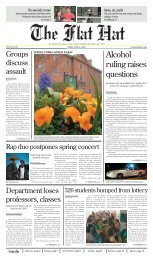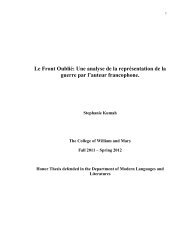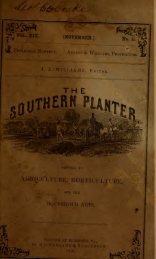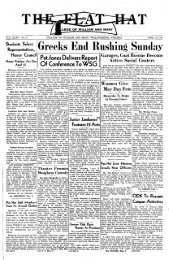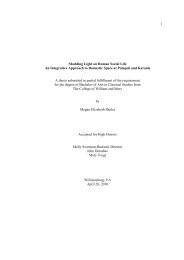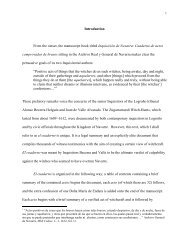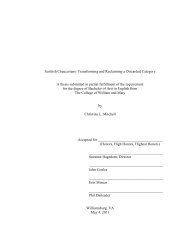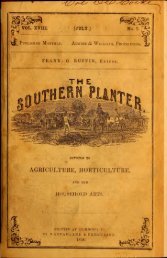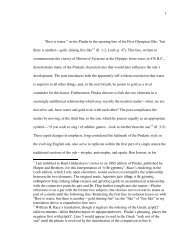Southern planter - The W&M Digital Archive
Southern planter - The W&M Digital Archive
Southern planter - The W&M Digital Archive
Create successful ePaper yourself
Turn your PDF publications into a flip-book with our unique Google optimized e-Paper software.
1908.] THE SOUTHERN PLANTER. 17<br />
offered by Dr. J. B. Emerson for the best display of apples.<br />
He took prizes on nearly every entry he made. <strong>The</strong> officers<br />
of the Society were re-elected with one or two minoi<br />
changes of Vice-Presidents. <strong>The</strong> Hon. G. B. Murrell,<br />
President; Walter Wh'ately, Secretary and Treasurer,<br />
and Prof. H. L. Price. Recording Secretary. We congratulate<br />
the society on the success of the meeting at which more<br />
new members were elected than at any previous gathering.<br />
THE SCUPPERNONG GRAPE.<br />
Editor <strong>Southern</strong> Planter:<br />
<strong>The</strong> States of Virginia, North Carolina and South Carolina<br />
have a valuable grape in the Scuppernong.<br />
It reaches its greatest perfection in the counties bordering<br />
the Atlantic, and the Sounds of Albemarle and<br />
Pamlico.<br />
It has been tried with indifferent success in many other<br />
States. <strong>The</strong> vine grows quickly, is long-lived, hardy and<br />
vigorous, and almost immune from disease.<br />
It is the largest domestic grape known, often meas-<br />
uring two and a half to three inches in circumference.<br />
When the fruit is ripening its fragrance fills the air with<br />
a delicious aroma. <strong>The</strong> skin is thick and tough, but (the<br />
fruit soft and juicy with a luscious flavor peculiarly its<br />
own. It is extremely popular in the South for the table,<br />
and as a wine grape the demand far exceeds the spply.<br />
Commercially, this grape could be made a most valu-<br />
able asset in the section indicated, but as yet very littl€<br />
attention has been given to it as a means of revenue.<br />
With care and cultivation a thrifty vine will produce more<br />
than double the amount of fruit and wine per acre of<br />
any grape in the world. <strong>The</strong> vines commence to bear the<br />
second year. It is estimated from vines five years old,<br />
an income of from $200 to $500 per acre can be secured,<br />
^iftaws<br />
? i'i?M<br />
^ dk<br />
while more than double that amount can be depended on<br />
in ten or twelve years.<br />
In fifteen years au acre should yield an income of from<br />
$1,000 to $1,500. A well-cared for vineyard has been<br />
known to yield over a thousands bushels to the acre in<br />
a good season.<br />
<strong>The</strong> market price this year has been from $1.75 to $2.00<br />
per. bushel of sixty pounds. Under present conditions<br />
the possibilities are immense. It is a crop that never<br />
fails, and the cost of cultivation, after the first year,<br />
compared with the labor expended on cotton, tobacco,<br />
peanuts, etc., is trifling. One hundred and ten vines to<br />
(<br />
-#*-<br />
+tf<br />
:<br />
.• ~/'<br />
'-: 0% ft<br />
'.^~<br />
M<br />
|K'C: ^3«ii t:£& :> :..«,/ : ,:,?<br />
the acre is enough. Eac h vine should average eight to<br />
ten bushels.<br />
Good grape growing lands can be bought to-day In<br />
Eastern North Carolina for $8 to $12 per acre, and we<br />
have shown that in fifteen years a ten-acre farm should<br />
yield an income of from $10,000 to $15,000 per year.<br />
<strong>The</strong> fruit makes a clear, light wine of very delicate<br />
flavor, and, as before stated, the demand so far exceeds the<br />
supply, that the product of a vineyard is engaged in<br />
advance from year to year.<br />
Before planting the ground must be well plowed and<br />
fertilized. Posts placed at intervals of 10 or 12 feet, 7<br />
feet high, with wire or slats overhead make the most<br />
approved arbor. No trimming is done to the vines, and as<br />
the fruit ripens it is quickly gathered by shaking it into<br />
sheets or canvas placed beneath.<br />
Harking back to 1586 we read in the report made to<br />
Sir Walter Raleigh by Captain Amadas upon his return<br />
to England from Roanoke Island, North Carolina, the<br />
following reference to grapes: "Which being performed<br />
(i. e. possesion taken) according to the ceremonies used<br />
in such enterprises, we viewed the land about us, being<br />
very sandy and low toward the water side, but so full of<br />
grapes as the very beating and surge of the sea over-<br />
flowed them that I think in all the world the like<br />
abundance is not to be found, and myself having seen<br />
those parts of Europe that most abound, find such dif-<br />
ference as were incredible to be written."<br />
<strong>The</strong> larger vine shown in the illustration is believed to<br />
be over 300 years old. It is still growing, hearty and<br />
vigorous, on Roanoke Island, N. C, not far from the or-<br />
iginal landing place of Captain Amadas and his colonists,<br />
and where for the first time the flag of old England was<br />
unfurled to the breezes of the new World.<br />
<strong>The</strong> smaller vine is but four years old; it extends a distance<br />
of over 30 feet from end to end, and at least 10<br />
feet of the vine to the left does not show in the picture.<br />
It yielded well the past season, and would have done<br />
better had it been trailed on an overhead arbor, instead<br />
of on an upright one. It shows the rapid growth of this<br />
species. It is located on Carter's Creek, Lancaster<br />
County, Virginia, not far from the Rappahannock river.<br />
Lancaster Co., Va.<br />
A. D. DART.<br />
,<br />
''<br />
\<br />
'



